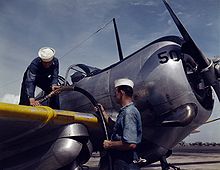Curtiss-Wright CW-22 Video - Picture

|
|
Curtiss-Wright CW-22
CW-22/SNC

Picture - A U.S. Navy SNC-1 in April 1942
Role: Fighter and advanced trainer
Manufacturer: Curtiss-Wright Corporation
First flight: 1940
Introduced: 1942
Primary users: United States Navy
Royal Netherlands East Indies Army Air Force
Number built: 600+
The Curtiss-Wright CW-22 was a 1940s American general-purpose advanced training monoplane aircraft built by the Curtiss-Wright Corporation. It was operated by the United States Navy as a scout trainer with the designation SNC-1 Falcon.
Design and development
Developed at the Curtiss-Wright St. Louis factory, the CW-22 was developed from the CW-19 via the single-seat CW-21 light fighter. The prototype first flew in 1940. With less power and performance than the CW-21, the two-seat, low-wing, all-metal CW-A22 had retractable tailwheel landing gear, with the main gear retracting rearwards into underwing fairings.
The CW-22 was seen as either a civilian sport or training monoplane or suitable as a combat trainer, reconnaissance and general-purpose aircraft for military use. The prototype CW-A22 Falcon (US civilian registration NC18067) was used as a company demonstrator and is one of four of the type still in existence. An SNC-1 is on display at the U.S. Navy National Museum of Naval Aviation, at Pensacola, Florida (USA).
Operational history

Picture - A CW-22 of the ML-KNIL, 1940.
The main customer for the Wright R-975 Whirlwind radial engine-powered aircraft was the Royal Netherlands East Indies Army Air Force and 36 were exported. The aircraft had to be delivered to the Dutch in Australia due to the advancing Japanese forces. A developed version, the CW-22B was sold to Turkey (50) and the Netherlands East Indies (25) and in small numbers in South America. Some of the Dutch aircraft were captured and operated by the Japanese air force. The CW-22 and CW-22B were armed with two machine guns, one fixed.
An unarmed advanced training version (CW-22N) was demonstrated to the United States Navy. To help to meet the expanding need for training planes the Navy ordered 150 planes in November 1940. Further orders brought the total to 305 aircraft which were designated SNC-1 Falcon.
Variants

Picture - Refueling of an SNC-1 at NAS Corpus Christi, 1942.
CW-A22
Prototype
CW-22
Production armed variant for the Royal Netherlands East Indies Army Air Force, 36 built.
CW-22B
Improved armed variant, approx 100 built.
SNC-1 Falcon (CW-22N)
United States Navy designation for the CW-22N, 305 built (BuNo 6290-6439, 05085-05234, 32987-32991).
Operators
Bolivia Dutch East Indies
Royal Netherlands East Indies Army Air Force
Japan
The Imperial Japanese Army Air Force operated captured ex-Dutch aircraft.
Peru Turkey United States
United States Navy
Uruguay
Uruguayan Air Force
Specifications (SNC-1)
Data from
General characteristics
Crew: Two
Length: 9 ft 11 in (8.23 m)
Wingspan: 35 ft 0 in (10.67 m)
Height: 9 ft 11 in (3.02 m)
Wing area: 173.70 ft² (16.14 m²)
Empty weight: 2,736 lb (1,241 kg)
Gross weight: 3,788 lb (1,718 kg)
Powerplant: 1 x— Wright R-975-28 Whirlwind radial piston engine, 420 hp (313 kW)
Performance
Maximum speed: 198 mph (319 km/h)
Range: 780 miles (1,255 km)
Service ceiling: 21,800 ft (6,645 m)
Bibliography
Andrade, John. U.S. Military Aircraft Designations and Serials since 1909. Hinckley, UK: Midland Counties Publications, 1979. ISBN 0-904597-22-9.
Bowers, Peter M. United States Navy Aircraft since 1911. Annapolis, MD: Naval Institute Press, 1990. ISBN 0-87021-792-5.
Donald, David, ed. The Encyclopedia of World Aircraft. Etobicoke, Ontario: Prospero Books, 1997 ISBN 1-85605-375-X.
The Illustrated Encyclopedia of Aircraft (Part Work 1982-1985). London: Orbis Publishing, 1985.
Curtiss-Wright CW-22 Pictures
More aircraft.
Source: WikiPedia